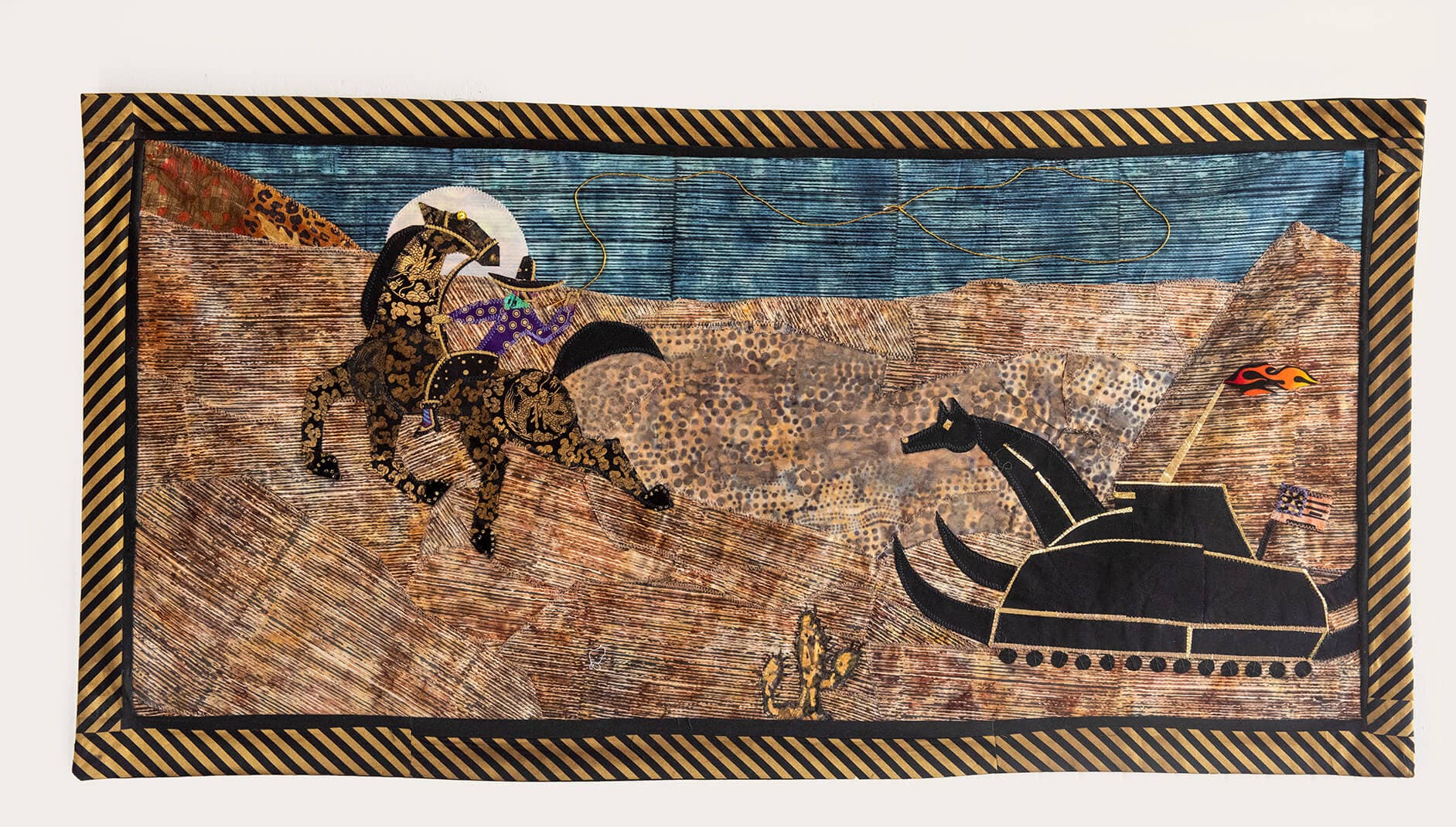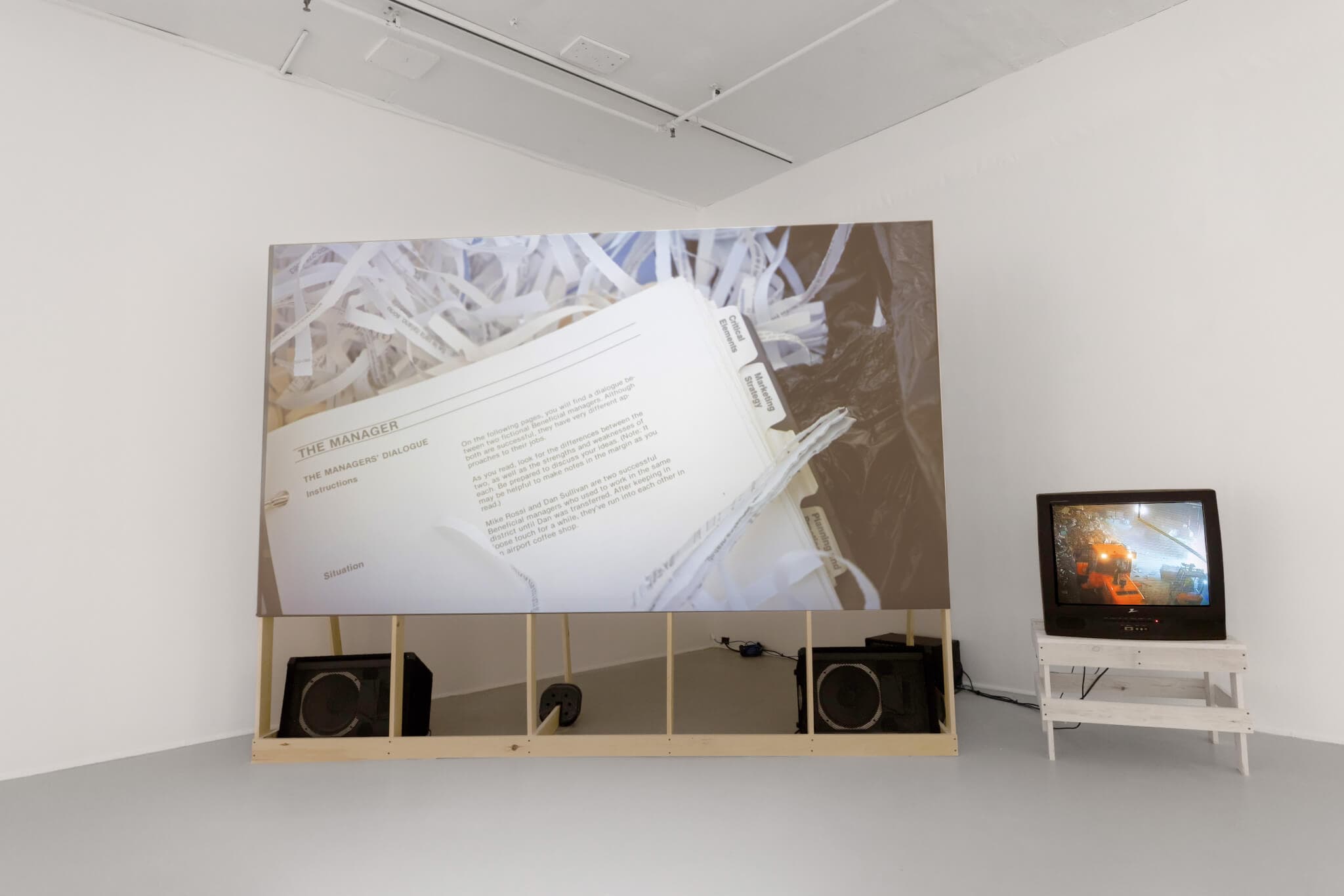A new year, a new president, and a news cycle that feels impossible to keep up with has got us looking for sites of respite and reflection. Our editors have compiled a list of shows, all within two hours of Boston, that can be enjoyed by popping into a gallery on an afternoon running errands or made into a day trip at a nearby museum.

Clara Wainwright, The Failed Lasso of the Trojan Rocker, 2024. Fabric collage, acrylic & marker. 46 ½ x 23 ½ inches. Photo by Richard Howard. Courtesy of Paul Deitrich Gallery.
“GLORY,” January 6–March 28, 2025
Paul Deitrich Gallery
20 University Road, Cambridge
Threading humor throughout her quilts, Clara Wainwright interrogates structures of power that define our social and political landscapes. Works in “GLORY” imaginatively take up President Donald Trump’s rise to office: the persistence of his supporters, elephantine gifts from other world leaders, and his encounters with popular culture in a peculiar pursuit of a character that transforms from Beyoncé Knowles-Carter to Vice President Kamala Harris. Wainwright found her voice using her hands to make quilts in the 1970s and has since been dedicated to guiding members of her communities in Boston to do the same by teaching youth art classes and leading group quilting projects. She focuses not on precision of line but of expression; characteristically, her vibrant quilts like Cowboy Carter (2024) and The Failed Lasso of the Trojan Rocker (2024) provoke laughter and inquisition. Wainwright embraces space wherein the serious and the ridiculous coexist.
—Alisa Prince

Installation view, “Margaret Wise Brown & Her Artists,” 2025. On view at the Eric Carle Museum of Picture Book Art through August 3, 2025. Photo courtesy of the Eric Carle Museum of Picture Book Art.
“Margaret Wise Brown & Her Artists,” January 8–August 3, 2025
The Eric Carle Museum of Picture Book Art
125 West Bay Road, Amherst
In the field of children’s literature, Margaret Wise Brown, the author of Goodnight Moon (1947) and The Runaway Bunny (1942), is a giant. At the time of her premature death at age forty-two in 1952, she left behind over a hundred children’s books that transformed the genre from one governed by moralistic fables to one foregrounding sensory engagement and kids’ everyday experiences. With a pulse on the avant-garde artistic and literary movements of her day, she commissioned illustrations from ambitious modern artists such as Clement Hurd, Leonard Weisgard, and Garth Williams. An exhibition at The Eric Carle Museum of Picture Book Art promises to provide a fresh look at Brown’s extraordinary collaborative work and unparalleled, enduring legacy.
—Jackson Davidow

(left) Melissa Joseph, Built-Ins, installation view, 2023. Linen pulp paint on abaca base sheet. 40 x 60 inches. (right) Julia Norton, Excavation, installation view, 2023. Assemblage with various papers, black walnut ink, ochre pigment, soil, lapis lazuli, bone black (from cow bones), rocks, devil’s seed pods, sheep wool, naturally dyed yarn, and opossum vertebrae. 68 x 80 inches. Installation view, “Pulp Memories,” 2025. On view at Praise Shadows Art Gallery through February 13, 2025. Photo by Dan Watkins Photography. Courtesy of Praise Shadows Art Gallery.
“Pulp Memories,” January 11–February 15, 2025
Praise Shadows Art Gallery
313A Harvard Street, Brookline
This exhibition invites viewers into a world where innovative techniques meet heartfelt storytelling. “Pulp Memories” marks the first joint presentation of New York City-based artists Melissa Joseph and Julia Norton. These artists explore storytelling through innovative papermaking and painting techniques. Joseph’s vivid paintings on handmade paper translate the physicality of wool felting and ceramics into fluid, figurative gestures rooted in old family photographs. Norton’s natural-material assemblages connect abstraction to landscape and anatomy, incorporating handmade paper infused with fibers, like agave and alpaca wool, as well as found objects, such as stones and seed pods. Both artists’ works resonate with care, crafting a poignant narrative of memory, nature, and the intimate act of creation through labor-intensive processes and evocative subjects, offering viewers a tender and transformative experience.
—Kaitlyn Ovett Clark

Ifé Franklin, Conjure Bottle with Medicine Bags. Courtesy of RSM Art Gallery at the Bentley Library.
“The Resurrection of Ifé Franklin,” January 15–March 1, 2025
RSM Gallery, Bentley University
175 Forest Street, Waltham
Ifé Franklin is a storyteller through and through. For over a decade, Franklin has created a body of work under The Indigo Project, which honors the lives and legacies of formerly enslaved individuals by pulling overlooked histories and cultural traditions into the present through powerful installations, performances, processions, writing, and sacred objects. At Bentley University’s RSM Gallery, her solo exhibition “The Resurrection of Ifé Franklin” functions as a mini retrospective that highlights the craft, research, and spirituality that is central to Franklin’s practice. Working with adire fabric—a traditional Yoruba technique for indigo-dying cotton with deep blues and rich white relief patterns—Franklin has created replicas of slave cabins that become sites for community gatherings and honoring ancestors. Inside the gallery, panels from her 2017 slave cabin installation hang from the ceiling. Franklin’s work is always operating across multiple realms: sculptures and drawings that incorporate symbols from the Kongo cosmogram reveal connections between cosmic and cellular systems, while the debut of her conjure bottles are informed by the Nkisi tradition of creating vessels that are believed to be inhabited by the spirits of ancestors. While rich with history and homage, Franklin’s work is made distinct by the joy and tenacity she brings to everything she touches.
—Jameson Johnson

Installation view, Maia Chao and Fred Schmidt-Arenales, “Waste Scenes,” 2025. On view at Boston Center for the Arts through March 29, 2025. Photo by Melissa Blackall. Courtesy of Boston Center for the Arts.
“Waste Scenes,” January 18–March 29 2025
Boston Center for the Arts
539 Tremont Street, Boston
In the Mills Gallery at BCA, a two-channel video installation captures a peculiar outdoor scene: framed artwork is suspended in midair above a row of chairs; a towering pile of rubbish looms behind them. Isolate the foreground composition and you have the makings of a typical office waiting room. Yet these items, among others, were tossed on a curb by their original owners and, with special permissions, eventually collected and strategically arranged by artists Maia Chao and Fred Schmidt-Arenales.
Featuring a sound-based performance by members of Mobius Artists Group during the opening reception, as well as found objects, audio, and film, the exhibition invites viewers to consider humans’ brazen excess consumption and flippant disposal of material goods. A print series and wall drawings round out the exhibition, aptly titled “Waste Scenes,” in an exploration of—and honest (and sometimes humorous) attempt to break down—the neoliberal ideology at the crux of an abhorrent system of material decomposition.
—Ava Mancing

Tara Sellios, Abundantia from the series Ask Now the Beasts, 2023. Inkjet print from 8 X 10 inch negative. 40 X 26 inches. Courtesy of the artist and Fitchburg Art Museum.
“Tara Sellios: Ask Now the Beasts,” January 18, 2025–January 18, 2026
Fitchburg Art Museum
185 Elm Street, Fitchburg
My inner goth is geeking out for local artist Tara Sellios’s large-format photographs, which locate beauty in darkness and decay. Drawing on Catholic iconography and Dutch still-life aesthetics. Sellios assembles fragile materials—dried rosebuds, desiccated grapes, bird bones, spider specimens—into sculptural tableaux, then photographs them using natural light and an 8 × 10 camera. The artist then removes all traces of the wires and pins, leaving behind memento mori that look like they’re levitating. Sellios’s first solo museum show borrows its title from the book of Job, but she takes a page from Revelation too, delivering apocalyptic vibes that feel right on time.
—Jacqueline Houton

(left to right) Lola Brooks, tenderloin, 2023; Kat Cole,, Landscape, 2023; Sean Eren, Caraspace, 2023;Jillian Moore, Mons Bola, 2023; Wyatt Nestor-Pasicznyk, A Wilder Blue, 2023; JJ Otero, Land Back, 2023; Jodi Webster, It Will Always Be Skunk Hill, 2023. Photo by Dasha Wright. Courtesy of Fuller Craft Museum.
“Everybody’s Bolos,” January 25–June 8, 2025
Fuller Craft Museum
455 Oak Street, Brockton
When I think of the bolo tie, I envision a thin rope and pendant slung around the neck of a cowboy as he wrangles his herd or heads to the local saloon for a whiskey. It’s a limited, unimaginative vision, at best, but it perhaps speaks to the accessory’s relatively short yet complicated history. For the past hundred years, the bolo tie has lived a liminal cultural existence, with strong ties to marginalized—Indigenous, Hispanic, LGBTQI+—communities, as well as appropriated by celebrities and hipsters alike.
For this traveling exhibition, thirty artists created their own versions of the bolo tie, often utilizing unexpected elements, like hand-painted flowers, pearls, and braided hair. Their modern takes make for untraditional and funky designs that lean into the bolo tie’s versatility, shedding its stereotypical, hyper-masculine symbolism, and transforming it into a form of adornment that tells meaningful stories of historical erasure, gender fluidity, and cultural traditions.
—Ava Mancing

Julie Andrée T. and Dominic Gagnon, “Silent Logistics” at Corporeal Heat Performance Festival, former D4 Police Station, South End, Boston, created and curated by students at the School of the Museum of Fine Arts working under Jamie McMurry in the performance area, 2004. Photo by Bob Raymond (Mobius Artists Group). Courtesy of Mobius Artists Group and Tufts University Art Galleries.
“an archive and/or a repertoire,” January 29–April 20, 2025
SMFA at Tufts
230 Fenway, Boston
“an archive and/or a repertoire,” an exhibition of artifacts and materials preserved by the Mobius, Inc. Records—the administrative archive of the Boston-based Mobius Artists Group—takes its title from performance arts scholar Diana Taylor’s seminal book and explores similarly dichotomous terrain: the ephemeral act of performance that engenders the residues captured in the archive, the archive that inspires further performances. Founded in 1977 by Marilyn Arsem, Mobius has been at the vanguard of performance art for nearly half a century, advancing the form and stress testing Taylor’s assertion that “performance … functions as an episteme, a way of knowing, not simply an object of analysis.” Now, visitors will have the chance to partake in that legacy by engaging with decades of documentation and witnessing live responses from artists like Forbes Graham and Takahiro Yamamoto. Together, audiences will shape the future of the archive in real time, enacting a “way of knowing” that will reverberate for years to come.
—Jessica Shearer

Hannah Altman, Telling You, 2021. Archival pigment print. 30 x 24 inches. Courtesy of the artist.
“As It Were, Suspended in Midair,” February 13–June 12, 2025
Kniznick Gallery at Brandeis University
515 South Street, Waltham
Hannah Altman’s photographs delve into the shared, inherited, and reshaped traditions of Jewish myths across the diaspora. Inspired by Yiddish literature and Jewish mystical texts, Altman crafts rich, enigmatic landscapes and intricate interiors where her female protagonists enact gestures and rituals. These figures challenge patriarchal narratives, embodying splendor and risk as they inhabit a symbolic world of suspense. Altman’s photographic practice transforms questioning into a ritual, inviting viewers into a world where allegory and iconography evolve toward futures rich with possibility. Her unfolding narratives forge connections between memory, myth, and the transformative power of storytelling. “As It Were, Suspended In Midair” emerges as a dynamic, speculative reworking of tradition, resonating across generations and landscapes.
—Kaitlyn Ovett Clark

Cauleen Smith, Pilgrim (still), 2017. Digital video (color, sound; 07:41 minutes). © Cauleen Smith. Courtesy the artist and Morán Morán, Los Angeles and Mexico City.
“Believers: Artists and the Shakers,” February 13–August 3, 2025
Institute of Contemporary Art / Boston
25 Harbor Shore Drive, Boston
In 1996, ten artists arrived in Sabbathday Lake, Maine, for an unusual residency—one in which they worked and worshipped alongside members of the last remaining Shaker community, creating art that was featured at Boston’s ICA in a 1998 exhibition. Now, just after the 250th anniversary of the Shakers’ arrival in America, works by five of those artists—Janine Antoni, Kazumi Tanaka, Wolfgang Tillmans, Nari Ward, and Chen Zhen—are returning to the museum (some in reimagined form) for “Believers: Artists and the Shakers.” They’re joined by more recent works by Jonathan Berger, Taylor Davis, Gordon Hall, Pallavi Sen, and Cauleen Smith (whose video Pilgrim, pictured here, traces a cross-country pilgrimage that ends in Watervliet, New York, the Shakers’ first settlement in America). There are two living Shakers left in Sabbathday Lake today, but this show underscores how the sect’s ideals and singular material culture—ranging from stunningly simple furniture to astonishingly vivid and intricate gift drawings—continue to have an outsized influence.
—Jacqueline Houton

Fabiola Jean-Louis (Haitian, 1978–), Out of Obsidian, 2024. Obsidian Stone, 23K gold, paper. ©2024 Fabiola Jean-Louis. Photo: Isabella Stewart Gardner Museum, Boston
“Waters of the Abyss: An Intersection of Spirit and Freedom,” February 27–May 25, 2025
Isabella Stewart Gardner Museum
25 Evans Way, Boston
Fabiola Jean-Louis draws on Vodou to bind the terrene to the divine. The works in the show highlight the role of Vodou in the Haitian Revolution, placing emphasis on the legacy of Black women who eluded and/or aided in dismantling systems of enslavement. With papier-mâché often providing a physical foundation, the multidisciplinary artist makes use of a breadth of materials such as crystal, glass, metal, shell, and stone to create spectacular figures and vessels. The warm illumination of her creations fosters a sense of communion as Jean-Louis shares both her personal and political histories, with an eye toward spiritual portals. Showcasing several new commissions, Jean-Louis’s work will fill all three of the Museum’s rotating exhibition spaces: the Hostetter Gallery, the Fenway Gallery, and the Anne H. Fitzpatrick Façade.
—Alisa Prince

June Leaf, White Scroll with Dancing Figures, 2008. Tin, wood, wire, acrylic on fabric, and wood. 17 x 17 ¼ inches. Private Collection. Photo courtesy of Addison Gallery of American Art.
“June Leaf: Shooting from the Heart,” March 15–July 31, 2025
Addison Gallery of American Art
3 Chapel Avenue, Andover
It is difficult to place June Leaf in histories of American contemporary art because she seemingly did everything over the course of a robust and energizing career that spanned seventy-five years. Best known for her kinetic sculptures, expressionistic ink drawings, and striking representations of goddess-like figures, Leaf, who died last year, cultivated a freewheeling yet disciplined practice that was almost always out of sync with the art world’s latest fads. Married to Robert Frank, the towering photographer and filmmaker whose career often overshadowed hers, Leaf has, only in recent years, been the recipient of the serious critical and curatorial attention she deserves. The most comprehensive exhibition of her work in more than three decades, “June Leaf: Shooting from the Heart” is sure to generate new critical frameworks for contextualizing and appreciating her fascinating oeuvre.
—Jackson Davidow

Jo Ann Rothschild, Hope, 2024. Mixed media, oil on canvas. 93.75 x 96 inches. Courtesy of HallSpace.
“Alone and Together,” March 22–April 26, 2025
HallSpace
950 Dorchester Avenue, Dorchester
From bold strokes of color on linen and canvas to black and white etchings and mixed media, Jo Ann Rothschild’s latest exhibition, “Alone and Together,” is an exploration of various modes of making. Opening March 22, the offering also points to the tension that exists in the relationship between the solitude of painting, the collaboration required of other modes such as printmaking, and what the audience might see, which Rothschild admits she’s curious of in a statement about her work which spans more than sixty years.
Rothschild’s art has been on display at the MFA, the Rose Museum, and el Taller de Gráphica. She was the first recipient of the Maud Morgan Purchase Prize of the MFA and a recipient of a grant in painting from the Massachusetts Cultural Council.
—Jacquinn Sinclair

Jenna Westra and Josh Brand, Leaf into Person, 2024. Unique chromogenic print. 14 x 10.5 inches. Photo courtesy of Anthony Greaney.
“Thinking Paw,” April 5–May 17, 2025
Anthony Greaney
438 Somerville Avenue, Somerville
Though still quite a ways out, I’m eager to catch the work of Jenna Westra and Josh Brand at Anthony Greaney’s loft-like Somerville space. Through photography, both artists explore the poetics of perception and gesture. For Westra, this results in layered photographs that capture a rotating cast of dancers, friends, and acquaintances in a series of movements that toy with performance and memory. Sometimes choreographed, oftentimes improvised, the characters in her photographs take on a dreamy quality as they are presented in cropped, layered, or otherwise obscured forms with intertwined limbs. Whereas Westra is interested in the manipulation of her subject matter, Brand is interested in the manipulation of the photographs themselves. A self-described “tinkerer,” Brand’s pictures are awash with surprising hues and punctuated by lines and shadows of not-so-identifiable forms. The exhibition will present a series of work by each artist as well as new, collaborative pieces that the duo have been developing together since 2021 where found materials are layered on top of their respective film negatives before being exposed to different photographic processes such as xerox, photogram, or contact prints.
—Jameson Johnson













